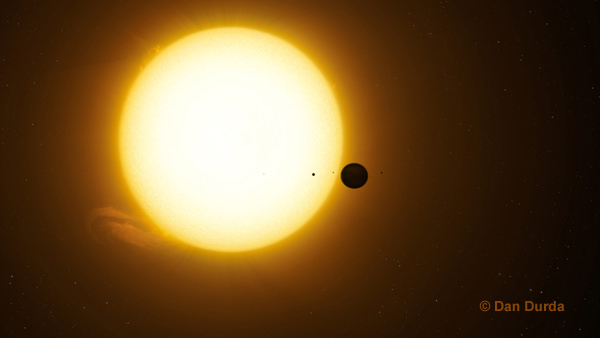I firmly believe that our next greatest discovery will be detecting an exomoon in orbit around a distant exoplanet. Although no one has been able to confirm an exomoon — yet — the hunt is on.
Now, a research team thinks following a trail of radio wave emissions may lead astronomers to this groundbreaking discovery.
The difficulty comes in trying to spot an exomoon using existing methods. Some astronomers think that hidden deep within the wealth of data collected by NASA’s Kepler mission are miniscule signatures confirming the presence of exomoons.
If an exomoon transits the star immediately before or just after the planet does, there will be an added dip in the observed light. Although astronomers have searched through Kepler data, they’ve come up empty handed.
So the team, led by Ph.D. student Joaquin Noyola, from the University of Texas at Arlington, decided to look a little closer to home. Specifically, Noyola and colleagues analyzed the radio wave emissions that result from the interaction between Jupiter, and it’s closest moon, Io.
During its orbit, Io’s ionosphere interacts with Jupiter’s magnetosphere — a layer of charged plasma that protects the planet from radiation — to create a frictional current that emits radio waves. Finding similar emissions near known exoplanets could be the key to predicting where moons exist.
“This is a new way of looking at these things,” said Noyola’s thesis advisor, Zdzislaw Musielak, in a press release. “We said, ‘What if this mechanism happens outside of our Solar System?’ Then, we did the calculations and they show that actually there are some star systems that if they have moons, it could be discovered in this way.”
The team even pinpointed two exoplanets — Gliese 876b, which is about 15 light-years away, and Epsilon Eridani b, which is about 10.5 light-years away — that would be good targets to begin their search.
With such a promising discovery on the horizon, theoretical astronomers are beginning to address the factors that may deem these alien moons habitable.
“Most of the detected exoplanets are gas giants, many of which are in the habitable zone,” said coauthor Suman Satyal, another Ph.D. student at UT Arlington. “These gas giants cannot support life, but it is believed that the exomoons orbiting these planets could still be habitable.”
Of course one look at Io shows the drastic effects a nearby planet may have on its moon. The strong gravitational pull of Jupiter distorts Io, causing its shape to oscillate, which generates enormous tidal friction. This effect has led to over 400 active volcanoes.
But a moon at a slightly further distance could certainly be habitable. A second look at Europa — Jupiter’s second-most inner satellite — demonstrates this facet. It’s possible that life could very well exist under Europa’s icy crust.
Exomoons may be frequent, habitable abodes for life. But only time will tell.
The findings have been published in the Aug. 10 issues of the Astrophysical Journal and are available online.


Quoting article:
“These gas giants cannot support life, but it is believed that the exomoons orbiting these planets could still be habitable.”
Just a nitpick – This should read:
“…These gas giants cannot support life as we know it, but it is believed that the exomoons orbiting these planets could still be habitable for earth-like lifeforms.”
Since we have only ever had one probe briefly sniff the atmosphere of a gas giant (Galileo probe in its fiery and brief death dive) and with just one example of a planet that supports life (Earth), it is a bit hasty to conclude the rest of the universe is lifeless based on one known model…
@weeasle: I’m one of the co-authors of the paper and I totally agree with your revised statement on habitability.